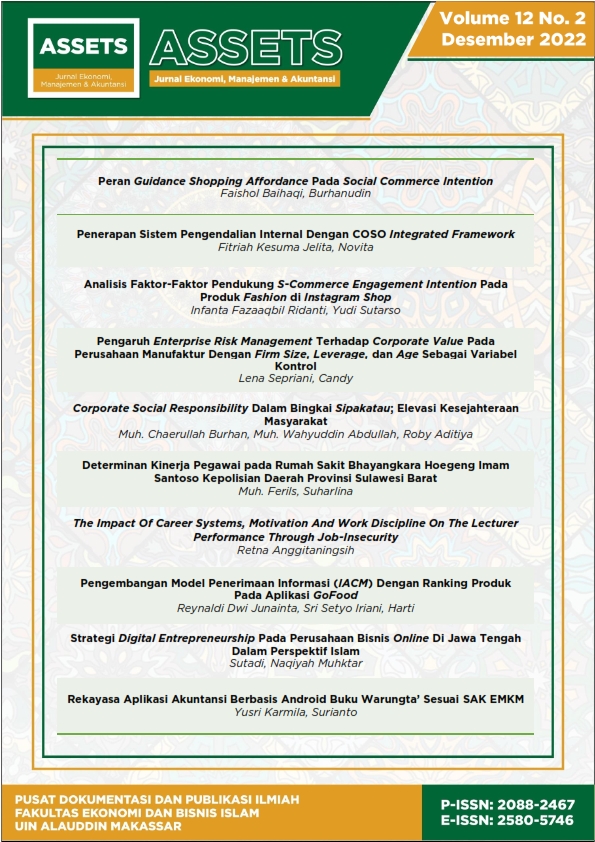ANALISIS FAKTOR-FAKTOR PENDUKUNG S-COMMERCE ENGAGEMENT INTENTION PADA PRODUK FASHION DI INSTAGRAM SHOP
Abstract
Fenomena belanja online telah menjadi suatu kebiasaan. Saat ini, masyarakat tidak hanya bertransaksi melalui e-commerce, tetapi s-commerce (social commerce) juga mulai diminati. Maraknya fenomena s-commerce khususnya pada media sosial Instagram Shop mendorong peneliti untuk membuat penelitian yang bertujuan guna menganalisa faktor-faktor apa saja yang dapat memengaruhi keterlibatan pengguna pada aktivitas s-commerce di Instagram Shop. Variabel yang digunakan adalah metasuara (metavoicing), pengalaman optimal (flow experience), keterlibatan komunitas (community engagement), dan kepercayaan pada penjual (trust in seller) terhadap s-commerce engagement intention. Data diperoleh dari hasil survei melalui kuesioner sebanyak 140 responden pengguna Instagram Shop di Surabaya dan sekitarnya. Analisis data diuji dengan menggunakan software WarpPLS dengan metode penelitian kuantitatif. Temuan pada penelitian ini menjelaskan bahwa metasuara berpengaruh pada keterlibatan komunitas, pengalaman optimal dan kepercayaan pada penjual. Pengalaman optimal itu sendiri juga berpengaruh pada keterlibatan komunitas. Selain itu, keterlibatan komunitas dan kepercayaan pada penjual terkonfirmasi berpengaruh positif pada s-commerce engagement intention namun variabel ini terkonfirmasi tidak dipengaruhi oleh pengalaman optimal.
References
Bhagwan, R., Naidu, L., & Panwar, M. (2021). Transcending University Boundaries: Community Engagement as a Tool to Enhance Social Work Students Preparedness for Real World Practice. Social Work Education, 41(6), 1–18. https://doi.org/10.1080/02615479.2021.1933931
Castillo, A., Benitez, J., Llorens, J., & Luo, X. (Robert). (2021). Social Media-Driven Customer Engagement and Movie Performance: Theory and Empirical Evidence. Decision Support Systems, 145(6), 1–11. https://doi.org/10.1016/j.dss.2021.113516
DailySocial.id. (2019). E-Commerce vs Social Commerce: Adu Kemudahan Berbelanja Online | DailySocial.id. https://dailysocial.id/post/e-commerce-vs-social-commerce-adu-kemudahan-berbelanja-online
DataIndonesia.id. (2022). Pengguna Media Sosial di Indonesia Capai 191 Juta pada 2022. https://dataindonesia.id/digital/detail/pengguna-media-sosial-di-indonesia-capai-191-juta-pada-2022
Furner, C. P., Drake, J. R., Zinko, R., & Kisling, E. (2022). Online Review Antecedents of Trust, Purchase, and Recommendation Intention: A Simulation-Based Experiment for Hotels and AirBnBs. Journal of Internet Commerce, 21(1), 79–103. https://doi.org/10.1080/15332861.2020.1870342
Goertzen, M. (2017). Applying Quantitative Methods to E-Book Collections. Library Technology Reports, 53(4), 12–18. https://doi.org/https://doi.org/10.5860/ltr.53n4
Hair, J. F., Risher, J. J., Sarstedt, M., & Ringle, C. M. (2019). When to Use and How to Report the Results of PLS-SEM. European Business Review, 31(1), 2–24. https://doi.org/10.1108/EBR-11-2018-0203
Hallem, A. P. Y., Abbes, A. P. I., Hikkerova, P. L., & Taga, M. P. N. (2021). A Trust Model for Collaborative Redistribution Platforms : A Platform Design Issue. Technological Forecasting and Social Change, 170(9), 1–10. https://doi.org/10.1016/j.techfore.2021.120943
Henseler, J., Ringle, C. M., & Sarstedt, M. (2015). A New Criterion for Assessing Discriminant Validity in Variance-Based Structural Equation Modeling. Journal of the Academy of Marketing Science, 43(1), 115–135. https://doi.org/10.1007/s11747-014-0403-8
Li, Y., & Peng, Y. (2021). What Drives Gift-giving Intention in Live Streaming? The Perspectives of Emotional Attachment and Flow Experience. International Journal of Human-Computer Interaction, 37(14), 1317–1329. https://doi.org/10.1080/10447318.2021.1885224
Lin, X., & Kishore, R. (2021). Social Media-Enabled Healthcare : A Conceptual Model of Social Media Affordances, Online Social Support, and Health Behaviors and Outcomes. Technological Forecasting and Social Change, 166(5), 1–15. https://doi.org/10.1016/j.techfore.2021.120574
Malak, F., Ferreira, J. B., Pessoa de Queiroz Falcão, R., & Giovannini, C. J. (2021). Seller Reputation Within the B2C e-Marketplace and Impacts on Purchase Intention. Latin American Business Review, 22(3), 287–307. https://doi.org/10.1080/10978526.2021.1893182
Manchanda, M., Deb, M., & Lomo-David, E. (2021). Scrutinizing the Efficacy of Branded Apps Quality to Counter Counterfeiting and Restore Trust in M-Commerce. Quality Management Journal, 28(3), 156–174. https://doi.org/10.1080/10686967.2021.1920869
Molinillo, S., Liébana-Cabanillas, F., & Anaya-Sánchez, R. (2018). A Social Commerce Intention Model for Traditional E-Commerce Sites. Journal of Theoretical and Applied Electronic Commerce Research, 13(2), 80–93. https://doi.org/10.4067/S0718-18762018000200107
Sekaran, U., & Bougie, R. (2016). Research Methods for Business: A Skill-Building Approach. Leadership & Organization Development Journal, 34(7), 1–447. https://doi.org/10.1108/lodj-06-2013-0079
Shen, X. L., Li, Y. J., Sun, Y., Chen, Z., & Wang, F. (2019). Understanding the Role of Technology Attractiveness in Promoting Social Commerce Engagement : Moderating Effect of Personal Interest. Information and Management, 56(2), 294–305. https://doi.org/10.1016/j.im.2018.09.006
Su, C., Min, Q., Scornavacca, E., & Liu, Z. (2021). A Dual-Role Trust Model for Social Commerce : A Guanxi Perspective. Information & Management, 58(7), 1–17. https://doi.org/10.1016/J.IM.2021.103512
Tuncer, I. (2021). The Relationship Between IT Affordance, Flow Experience, Trust, and Social Commerce Intention: An Exploration using the S-O-R Paradigm. Technology in Society, 65(5), 1–10. https://doi.org/10.1016/j.techsoc.2021.101567
Wang, J., Cai, S., Xie, Q., & Chen, L. (2021). The Influence of Community Engagement on Seller Opportunistic Behaviors in E-Commerce Platform. Electronic Commerce Research, 21(1), 1–29. https://doi.org/10.1007/s10660-021-09469-w
Wang, L., & Luo, X. (2021). Understanding the Interplay Between Government Microblogs and Citizen Engagement : Evidence from China. In Electronic Commerce Research (Vol. 21, Issue 2). Springer US. https://doi.org/10.1007/s10660-019-09376-1
Wang, Y., Wang, J., Yao, T., Li, M., & Wang, X. (2020). How does Social Support Promote Consumers’ Engagement in the Social Commerce Community? The Mediating Effect of Consumer Involvement. Information Processing and Management, 57(5), 1–14. https://doi.org/10.1016/j.ipm.2020.102272
Xue, J., Liang, X., Xie, T., & Wang, H. (2020). See Now, Act Now: How to Interact with Customers to Enhance Social Commerce Engagement? Information and Management, 57(6), 1–26. https://doi.org/10.1016/j.im.2020.103324
Yuan, C., Wang, S., Yu, X., Kim, K. H., & Moon, H. (2021). The Influence of Flow Experience in the Augmented Reality Context on Psychological Ownership. International Journal of Advertising, 40(6), 922–944. https://doi.org/10.1080/02650487.2020.1869387
Zhou, T. (2020). The Effect of Flow Experience on Users’ Social Commerce Intention. Kybernetes, 49(10), 2349–2363. https://doi.org/10.1108/K-03-2019-0198
Copyright (c) 2022 Assets : Jurnal Ekonomi, Manajemen dan Akuntansi

This work is licensed under a Creative Commons Attribution-NonCommercial-ShareAlike 4.0 International License.










